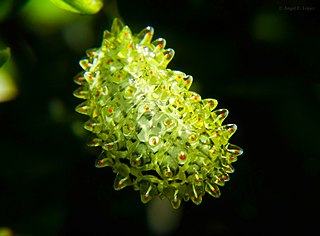Oroya aurora is a moth in the family Dalceridae, and the only species in the genus Oroya. Both the genus and the species were first described by Scott E. Miller in 1994. It is found in southern Peru and adjacent Bolivia. The habitat consists of tropical premontane wet, tropical premontane moist and subtropical (lower) montane wet forests.
Acraga ingenescens is a moth of the family Dalceridae. It is found in Venezuela. The habitat probably consists of tropical lower montane moist forests.
Acraga andina is a moth of the family Dalceridae. It is found in Andes Mountains of Venezuela, Colombia, Ecuador and Peru. The habitat consists of tropical wet, tropical premontane wet, tropical premontane moist and probably tropical montane wet forests.
Acraga flava is a moth of the family Dalceridae. It is found in southern Brazil and northern Argentina. The habitat consists of tropical premontane moist, subtropical wet, subtropical moist, subtropical lower montane wet, subtropical lower montane moist and warm temperate moist forests.
Acraga neblina is a moth of the family Dalceridae. It is found in Venezuela. The habitat consists of tropical premontane wet and tropical lower montane rain forests, where it is found at high altitudes.

Acraga moorei, the tangerine furry-legs, is a moth of the family Dalceridae. It is found in Venezuela, Colombia, Brazil, Ecuador, Peru, Bolivia, Paraguay and northern Argentina. The habitat consists of tropical wet, tropical moist, tropical premontane wet, tropical premontane moist, tropical lower montane wet, tropical lower montane moist, subtropical wet, subtropical moist, subtropical lower montane moist, subtropical montane wet or rain and warm temperate moist forests.

Acraga coa is a moth of the family Dalceridae. It is found in southern Mexico, Belize, Honduras, Guatemala, El Salvador, Costa Rica and Panama. The habitat consists of tropical wet, tropical moist, tropical premontane wet, tropical premontane rain, tropical lower montane moist, subtropical wet, subtropical moist, subtropical dry and warm temperate wet forests.
Acraga meridensis is a moth of the family Dalceridae. It is found in the Andes Mountains of Venezuela and Colombia. The habitat probably consists of tropical premontane and lower montane moist or wet forests.
Acraga mariala is a moth of the family Dalceridae. It is found in Colombia. The habitat consists of tropical lower montane or premontane wet and tropical lower montane moist forests.
Acraga hoppiana is a moth of the family Dalceridae. It is found in Colombia and Ecuador. The habitat consists of tropical wet, Tropical lower montane dry and possibly in tropical premontane rain forests.
Acraga brunnea is a moth of the family Dalceridae. It is found in southern Brazil. The habitat consists of subtropical moist and subtropical lower montane wet forests.
Dalcerides sofia is a moth in the family Dalceridae. It was described by Harrison Gray Dyar Jr. in 1910. It is found in southern Mexico, Guatemala, El Salvador, Nicaragua and Costa Rica. The habitat consists of tropical moist, tropical dry, tropical premontane wet, subtropical moist, subtropical dry and warm temperate wet forests.
Dalcerides dulciola is a moth in the family Dalceridae. It was described by Harrison Gray Dyar Jr. in 1914. It is found in southern Mexico, Costa Rica, Panama, northern Ecuador and northern Venezuela. The habitat consists of tropical wet, tropical moist, tropical premontane wet and tropical premontane rain forests.
Dalcerides mesoa is a moth in the family Dalceridae. It was described by Herbert Druce in 1887. It is found in southern Mexico, Guatemala, Costa Rica, Panama, Colombia, Venezuela and Ecuador. The habitat consists of tropical wet, tropical moist, tropical dry, tropical premontane wet, tropical premontane rain, subtropical wet and subtropical dry forests.
Zikanyrops sparsa is a moth in the family Dalceridae. It was described by Walter Hopp in 1928. It is found in southern Brazil. The habitat consists of subtropical lower montane moist forests.

Dalcera abrasa is a moth in the family Dalceridae. It is found in Colombia, Venezuela, Guyana, Suriname, French Guiana, Brazil, Peru and Bolivia. The habitat consists of tropical wet, tropical moist, tropical dry, tropical premontane wet, tropical premontane moist, tropical lower montane moist, subtropical moist, subtropical lower montane moist, warm temperate moist and warm temperate dry forests.
Minonoa elvira is a moth in the family Dalceridae. It was described by Paul Dognin in 1909. It is found in Colombia. The habitat consists of tropical lower montane and premontane wet forests.
Paracraga argentea is a moth in the family Dalceridae. It was described by Schaus in 1910. It is found in Mexico, Honduras, Belize, Guatemala, El Salvador, Costa Rica and Panama. The habitat consists of tropical wet, tropical moist, tropical premontane wet, tropical premontane moist, subtropical wet subtropical moist forests.
Paracraga canalicula is a moth in the family Dalceridae. It was described by Paul Dognin in 1910. It is found in Colombia and Peru. The habitat consists of tropical wet, tropical moist and tropical premontane wet forests.
Minacraga itatiaia is a moth in the family Dalceridae. It was described by S.E. Miller in 1994. It is found in southern Brazil. The habitat consists of subtropical wet, subtropical lower montane moist and warm temperate moist forests.


